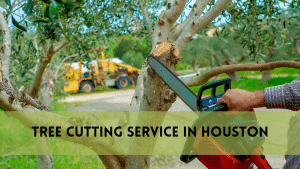Because of their profound roots in the ground, trees are frequently seen as emblems of stability and power. However, have you ever considered whether cutting down a tree can have unanticipated effects, especially on the foundation of your house? We’ll examine the possible relationship between foundation issues and tree removal in this extensive post, illuminating the relationship between these two apparently unconnected facets of homeownership.
The Benefits of Trees Can Get from Foundation Health
We must first acknowledge the vital function that trees play in preserving the structural integrity of your property in order to comprehend whether cutting down a tree might result in foundation issues.
Trees support and stabilize the soil surrounding your foundation with their extensive underground root systems. This root system aids in maintaining soil stability, halting erosion, and controlling moisture levels. Trees are essentially the natural protectors of the foundation of your house.
The Effects of Removing Trees on Foundation
Let’s go right to the point: what happens if you decide to get rid of a tree on your property? Tree removal involves more than just chopping the tree down; it also involves uprooting the tree’s massive root system. The earth may become disturbed by this and settle unevenly. This might leave your home’s foundation open to a number of problems.
Issues with the Foundation Associated with Tree Removal
Following a tree’s removal, the following foundation issues might surface:
Soil Shrinkage: Soil shrinkage can occur when a tree’s roots are absent. Uneven foundation settlement might result from the empty areas left by the soil’s contraction.
Soil Erosion: A tree’s root system no longer acts as a barrier against erosion. Rainwater has the power to remove soil, leaving your foundation vulnerable to harm.
Uneven settling of the foundation can cause structural issues, fissures, and shifts that might jeopardise your home’s stability.
Unbalanced Moisture: Trees help control the amount of moisture in the soil. Your soil might get too damp or too dry as a result of their removal, which could harm your foundation.
Indications of Foundation Issues because of Tree Removal
Understanding the warning indicators of foundation issues is crucial. These can show up in a number of ways:
Wall and Floor Cracks: If you see any noticeable cracks in your walls or floors, it may indicate that your foundation has moved or settled.
Uneven flooring: You should be concerned if there are discernible slopes or if your flooring seems uneven.
Sticking Doors and Windows: Having trouble opening and shutting doors and windows may be a sign of problems with the foundation.
Walls and Ceilings: Your foundation may be the cause of any spaces or divisions you see between your walls and ceilings.
Avoiding Foundation Issues After Tree Removal
Although the removal of trees may result in foundation issues, there are steps you may do to reduce these risks:
Speak with a Professional: To determine the possible effects on your foundation, speak with a structural engineer or arborist before taking down a tree.
Tree Root Barriers: To divert a tree’s roots away from your foundation, think about putting up root barriers.
Foundation upkeep: Check your foundation often for any indications of issues, and take quick action if necessary.
Sufficient Soil Management: Ensure that the soil surrounding your house has the ideal moisture balance. Appropriate irrigation and landscaping methods can help achieve this.
Actual Narratives of Removing a Tree Cause Foundation Problems
Let’s examine a few actual case studies to show how foundation issues and tree removal are related.
Case Study 1: The Tragic Cherry Blossom
A suburban couple named Sarah and John made the decision to get rid of a large cherry blossom tree on their property. Their goal was to make their kids’ play area more expensive.
They were unaware of the repercussions of their choice, though. Their home began to exhibit indications of foundation issues within a year. The flooring started to become clearly uneven, and there were cracks in the walls.
They frantically contacted a structural expert, who verified that the removal of the massive root system of the cherry blossom tree had resulted in soil shrinkage and foundation settlement. Their foundation required extensive repairs, which came at a high cost and provided a sobering lesson on the effects of tree removal.
Case Study 2: The House-Holding Oak
Robert’s front yard included a stately oak tree that added beauty and shade to the area. The oak tree had been a feature of the property for many years, but its massive roots were posing a threat to his driveway and walkway. He chose to cut down the oak tree after being presented with this choice.
Following the tree’s removal, Robert saw that the outside brickwork of his home was beginning to fracture and that his front porch had taken on a perceptible lean.
He sought the advice of a foundation specialist and an arborist because he was worried about these abrupt alterations. It was found that the foundation’s uneven settling was caused by the removal of the tree’s roots, which had kept the earth compressed.
Case Study 3: The Overgrown Maple
The Anderson family owned a maple tree in their backyard in a peaceful suburban area. The tree had grown greatly over the years, its branches reaching over their house.
Because of safety concerns, the family decided it was time to take down the tree. The tree was taken down by experts they hired, leaving a huge hole where the roots formerly were.
After a few months, they began to have problems with their basement. Wall fissures and water leaks started to happen often. Upon assessment, it was discovered that the removal of the maple tree had upset the soil’s moisture balance, making it too damp and contributing to basement issues. The Andersons were forced to spend money on pricey foundation repairs and waterproofing.
Is It Safe for the Foundation to Remove a Tree?
The aforementioned incidents demonstrate the possible dangers connected to tree removal. It’s crucial to remember, nevertheless, that tree removal is safe to do so as long as specific safety measures are followed. To be sure that cutting down a tree doesn’t cause issues with the foundation, follow these guidelines:
Consult Experts: When in doubt, seek the advice of arborists or tree removal professionals who are qualified to evaluate possible hazards and suggest mitigating measures.
Consider root trimming as an alternative to total removal in order to divert the tree’s roots away from your foundation.
Foundation check: It’s a good idea to perform a comprehensive check of your foundation both before and after tree removal in order to spot any damage or indications of settling early on.
Appropriate Soil Management: Make use of the right irrigation systems and landscaping strategies to keep the soil’s moisture content balanced.
Examine Alternatives: To lessen the threats to your foundation, look into tree trimming or pruning as an alternative to removal.
FAQs
Will Tree Removal Actually Affect the Foundation of My House?
Yes, cutting down a tree can seriously damage the foundation of your house. The earth surrounding your foundation is stabilised by the tree’s root system. The removal of the tree may cause the earth to settle unevenly and shift, which might cause foundation issues.
What Are a Few Typical Indications of Foundation Issues?
Answer: Visible wall and floor cracks, uneven flooring, stuck doors and windows, and spaces or gaps between walls and ceilings are typical indicators of foundation issues. It’s critical to take immediate action if you observe any of these symptoms.
How Can a Tree Be Safely Removed Without Endangering My Foundation?
In order to securely remove a tree without creating issues with the foundation, seek advice from experts like arborists or tree removal specialists. Alternatives include keeping appropriate soil moisture levels, inspecting the foundation both before and after tree removal, and cutting roots.
Can My Foundation Be Protected by Tree Root Barriers?
In order to divert tree roots away from your foundation, tree root barriers might be useful. One way to guard against potential damage from tree roots to your foundation is to install root barriers.
After removing a tree, What Should I Do If I Think My Foundation May Be Problematic?
It is imperative to seek advice from a structural engineer or foundation specialist if you suspect issues with your foundation following tree removal. They can evaluate the issue, suggest any required fixes, and assist you in getting the foundation of your house stable again.
Conclusion
In conclusion, it is not easy to answer the issue, “Can removing a tree cause foundation problems?” While it is conceivable, the likelihood of foundation problems following tree removal varies greatly depending on the kind of tree, how close the tree is to the foundation, and the precautions taken to reduce hazards. By being aware of the possible effects of tree removal and adopting preventative measures, homeowners may steer clear of expensive foundation issues.
Ultimately, it’s critical to handle tree removal cautiously and, if in doubt, seek professional help. Maintaining the soundness of your home’s foundation is essential, thus doing so should always be your first concern. You may take proactive steps and profit from a tree-free area without jeopardising the structural stability of your house if you have the necessary expertise.





